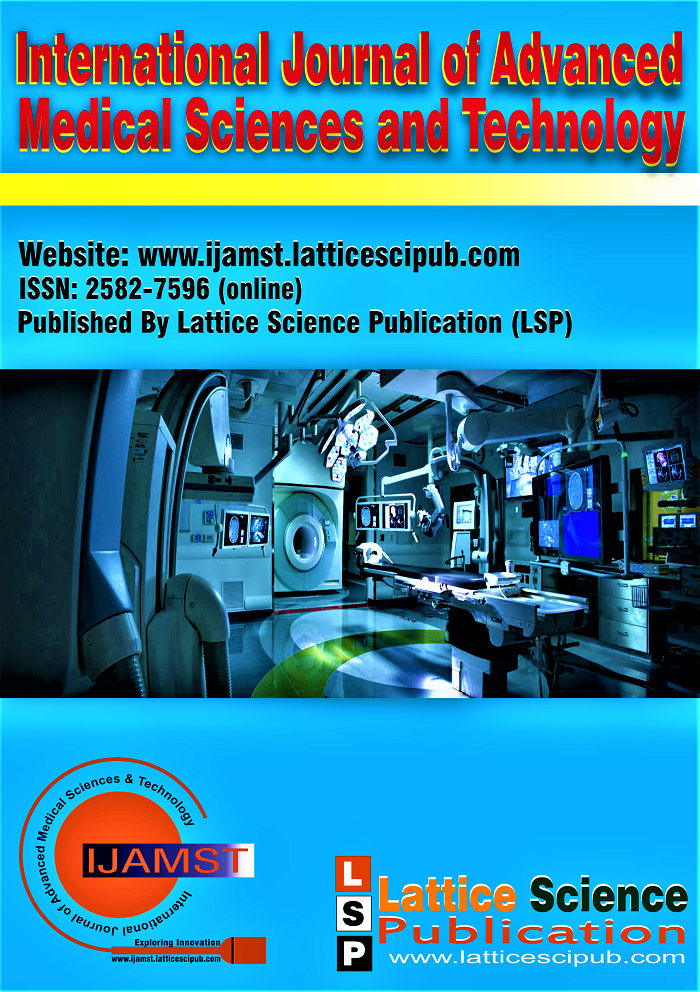COVID-19 Data Analysis using Chest X-Ray
Main Article Content
Abstract
The COVID-19 pandemic has caused large-scale outbreaks in more than 150 countries worldwide, causing massive damage to the livelihood of many people. The capacity to identify contaminated patients early and get unique treatment is quite possibly the primary stride in the battle against COVID-19. One of the quickest ways to diagnose patients is to use radiography and radiology images to detect the disease. Early studies have shown that chest X-rays of patients infected with COVID-19 have unique abnormalities. To identify COVID-19 patients from chest X-ray images, we used various deep-learning models based on previous studies. We first compiled a data set of 2,815 chest radiographs from public sources. The model produces reliable and stable results with an accuracy of 91.6%, a Positive Predictive Value of 80%, a Negative Predictive Value of 100%, specificity of 87.50%, and Sensitivity of 100%. It is observed that the CNN-based architecture can diagnose COVID-19 disease. The parameters’ outcomes can be further improved by increasing the dataset size and by developing the CNN-based architecture for training the model.
Downloads
Article Details

This work is licensed under a Creative Commons Attribution-NonCommercial-NoDerivatives 4.0 International License.
How to Cite
References
(2020). WHO Director-General’s Opening Remarks at the Media Briefing on COVID-19–11 March 2020. [Online]. Available: https://www.who. int/dg/speeches/detail/who-director-general-s-opening-remarks-at-themedia-briefing-on-covid-19—11-march-2020
L.L. Ren, Y.M. Wang, Z.Q. Wu et al., Identification of a novel coronavirus causing severe pneumonia in human: a descriptive study, Chin. Med. J. (Engl). 133(9)(2020), 1015-1024. [CrossRef]
G. Orive, U. Lertxundi, D. Barcelo, Early SARS-CoV-2 outbreak detection by sewage-based epidemiology, Sci. Total Environ. 732 (2020), 139298. [CrossRef]
I. Ghinai et al., First known person-to-person transmission of severe acute respiratory syndrome coronavirus 2 (SARS-CoV-2) in the USA, Lancet, 395 (10230) (2020), 1137–1144.
L. Palagi, A. Pesyridis, E. Sciubba, L. Tocci, Machine Learning for the prediction of the dynamic behavior of a small scale ORC system,
Energy. 166 (2019), 72–82.
[CrossRef]
L. Wang and A. Wong, "COVID-net: A tailored deep convolutional neural network design for detection of COVID-19 cases from chest radiography images," arXiv preprint arXiv: 2003.09871, 2020 [CrossRef]
X. Ouyang et al., "Dual-Sampling Attention Network for Diagnosis of COVID-19 from Community-Acquired Pneumonia," in IEEE Transactions on Medical Imaging, DOI: 10.1109/TMI.2020.2995508. [CrossRef]
X. Ouyang et al., "Dual-Sampling Attention Network for Diagnosis of COVID-19 from Community-Acquired Pneumonia," in IEEE Transactions on Medical Imaging, DOI: 10.1109/TMI.2020.2995508. [CrossRef]
X. Ouyang et al., "Dual-Sampling Attention Network for Diagnosis of COVID-19 from Community-Acquired Pneumonia," in IEEE Transactions on Medical Imaging, DOI: 10.1109/TMI.2020.2995508. [CrossRef]
S. Salehi, A. Abedi, S. Balakrishnan, and A. Gholamrezanezhad, ‘‘Coronavirus disease 2019 (COVID-19): A systematic review of imaging findings in 919 patients,’’ Amer. J. Roentgenology, vol. 215, pp. 1–7, Mar. 2020. [CrossRef]
Kermany, Daniel; Zhang, Kang; Goldbaum, Michael (2018), “Labeled Optical Coherence Tomography (OCT) and Chest X-Ray Images for Classification”, Mendeley Data, v2 http://dx.doi.org/10.17632/rscbjbr9sj.2
ResNet, AlexNet, VGGNet. Inception: Understanding Various Architectures of Convolutional Networks. Accessed: Jul. 5, 2020. [Online]. Available: https://cv-tricks.com/cnn/understand-resnet-alexnet-vgg-inception/
K. He, X. Zhang, S. Ren, J. Sun, Deep residual learning for image recognition, Proc. IEEE Comput. Soc. Conf. Comput. Vis. Pattern Recognit. 2016 (2016), 770–778.
K. He, X. Zhang, S. Ren, J. Sun, Deep residual learning for image recognition, Proc. IEEE Comput. Soc. Conf. Comput. Vis. Pattern Recognit. 2016 (2016), 770–778.
N. Tajbakhsh, J. Y. Shin, S. R. Gurudu, R. T. Hurst, C. B. Kendall, M. B. Gotway, and J. Liang, ‘‘Convolutional neural networks for medical image analysis: Full training or fine tuning?’’ IEEE Trans. Med. Imag., vol. 35, no. 5, pp. 1299–1312, May 2016. [CrossRef]
T. R. Muhammad E. H. Chowdhury, A. Khandakar, R. Mazhar, M. A. Kadir, Z. B. Mahbub, K. R. Islam, M. S. Khan, A. Iqbal, N. Al-Emadi, and M. Bin I. Reaz. (2020). COVID-19 Chest X-Ray Database. [Online]. Available: https://www.kaggle.com/tawsifurrahman/ covid19-radiography-database
S.-I. S. O. M. A. I. Radiology. (2020). COVID-19 Database. [Online]. Available: https://www.sirm.org/category/senza-categoria/ covid-19/
J. C. Monteral. (2020). COVID-Chestxray Database. [Online]. Available: https://github.com/ieee8023/covid-chestxray-dataset
(2020). Radiopedia. [Online]. Available: https://radiopaedia.org/ search?lang=us&page=4&q=covid+19&scope=all&utf8=%E2%9C%93
K. He, X. Zhang, S. Ren, J. Sun, Deep residual learning for image recognition, Proc. IEEE Comput. Soc. Conf. Comput. Vis. Pattern Recognit. 2016 (2016), 770–778.
A.H. Asyhar, A.Z. Foeady, M. Thohir, A.Z. Arifin, D.Z. Haq, D.C.R. Novitasari, Implementation LSTM Algorithm for Cervical Cancer using Colposcopy Data, in: 2020 International Conference on Artificial Intelligence in Information and Communication (ICAIIC), IEEE, Fukuoka, Japan, 2020: pp. 485–489. [CrossRef]
D. A. Van Dyk and X.-L. Meng, “The art of data augmentation,” Journal of Computational and Graphical Statistics, vol. 10, no. 1, pp. 1–50, 2001. doi: 10.1198/10618600152418584 [CrossRef]
Z. Hussain, F. Gimenez, D. Yi, and D. Rubin, “Differential Data Augmentation Techniques for Medical Imaging Classification Tasks,” in AMIA Annnual Symposium Proceedings, vol. 2017. American Medical Informatics Association, 2017, pp. 979–984.
Y. Xue, T. Xu, H. Zhang, L. R. Long, and X. Huang, ‘‘SegAN: Adversarial network with multi-scale l1 loss for medical image segmentation,’’ Neuroinformatics, vol. 16, nos. 3–4, pp. 383–392, Oct. 2018. [CrossRef]
Y. Wang, C. Dong, Y. Hu, C. Li, Q. Ren, X. Zhang, H. Shi, and M. Zhou, ‘‘Temporal changes of CT findings in 90 patients with COVID-19 pneumonia: A longitudinal study,’’ Radiology, Mar. 2020, Art. no. 200843. [Online]. Available: http://10.1148/radiol.2020200843 [CrossRef]
M. Mossa-Basha, C. C. Meltzer, D. C. Kim, M. J. Tuite, K. P. Kolli, and B. S. Tan, ‘‘Radiology department preparedness for COVID-19: Radiology scientific expert review panel,’’ Radiology, vol. 296, no.
, pp. E106–E112, Aug. 2020, doi: 10.1148/radiol.2020200988. [CrossRef]
Imaging Technology News. How Does COVID-19 Appear in the Lungs? Accessed: Jul. 15, 2020. [Online]. Available: https://www. itnonline.com/content/how-does-COVID-19-appear-lungs
L. Wang and A. Wong, ‘‘COVID-net: A tailored deep convolutional neural network design for detection of COVID-19 cases from chest X-ray images,’’ 2020, arXiv:2003.09871. [Online]. Available: http://arxiv.org/abs/2003.09871 [CrossRef]
T. Ozturk, M. Talo, E. A. Yildirim, U. B. Baloglu, O. Yildirim, and U. R. Acharya, ‘‘Automated detection of COVID-19 cases using deep neural networks with X-ray images,’’ Comput. Biol. Med., vol. 121, Jun. 2020, Art. no. 103792, doi: 10.1016/j.compbiomed.2020.103792. [CrossRef]





